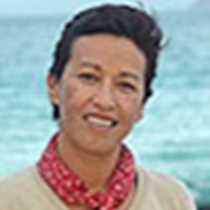Punta Vicente Roca on Isabela Island and Punta Espinoza on Fernandina
From sunrise to sunset this can be described as a wonderful day. The Islander sailed north of Isabela Island when a pod of dolphins were sighted by the crew members. Upon approach we could see that there were two different kinds of cetaceans, one known as common dolphin and the other one known as the striped dolphin. Several kinds of sea birds, including the very famous dark-rumped petrel, flew passing the bow of the ship. On our way to Punta Vicente Roca we had to pass the Equator line where King Neptune and his Nereid came to visit us. Expedition Leader Paula Tagle gave us certificates that say that we have crossed the Equator on board the Islander, so we are now officially declared as “Galápagos Shellbacks”.
We then went to explore the dramatic coast surrounded by shear-cut cliffs. This vantage point offered us the opportunity to see big marine iguanas, Galápagos fur seals, Nazca boobies, blue-footed boobies, brown noddy terns, Galápagos penguins and a very odd-looking fish known as Mola mola, or sun fish, which leaped or swam in front of our Zodiacs and the kayakers. Once in the water, sea turtles delighted us with their elegant swimming style, giving us the chance to have very close encounters.
At noon the Islander set sail towards the most pristine island in the world, Fernandina, the Naturalist's most favorite island. It is bathed by a very cold current that originates deep in the sea, dragging nutrients from its bottom. The current up-wells around here, generating a sea food change that attracts big marine mammals, and we were lucky to see Bryde’s whales and a large school of dolphins.
Fernandina is the youngest island of the Archipelago; laying over the hot spot, its last eruption was in May of 2005. From a distance, the island looks barren and makes us think deeply about the challenges and struggles that are presented for arrival and survival of the species. A sea bird has lost its aptitude to fly after finding a good feeding place and no predators to avoid: the Flightless cormorant. This species is the only cormorant to inhabit this place and the only flightless cormorant of the world. Their colonies are located only around Fernandina and the western coasts of Isabela Island. They became very good swimmers and explore the coast in pursuit of bottom living creatures. We left the island behind, but we know that the memories of it will always stay with us.
From sunrise to sunset this can be described as a wonderful day. The Islander sailed north of Isabela Island when a pod of dolphins were sighted by the crew members. Upon approach we could see that there were two different kinds of cetaceans, one known as common dolphin and the other one known as the striped dolphin. Several kinds of sea birds, including the very famous dark-rumped petrel, flew passing the bow of the ship. On our way to Punta Vicente Roca we had to pass the Equator line where King Neptune and his Nereid came to visit us. Expedition Leader Paula Tagle gave us certificates that say that we have crossed the Equator on board the Islander, so we are now officially declared as “Galápagos Shellbacks”.
We then went to explore the dramatic coast surrounded by shear-cut cliffs. This vantage point offered us the opportunity to see big marine iguanas, Galápagos fur seals, Nazca boobies, blue-footed boobies, brown noddy terns, Galápagos penguins and a very odd-looking fish known as Mola mola, or sun fish, which leaped or swam in front of our Zodiacs and the kayakers. Once in the water, sea turtles delighted us with their elegant swimming style, giving us the chance to have very close encounters.
At noon the Islander set sail towards the most pristine island in the world, Fernandina, the Naturalist's most favorite island. It is bathed by a very cold current that originates deep in the sea, dragging nutrients from its bottom. The current up-wells around here, generating a sea food change that attracts big marine mammals, and we were lucky to see Bryde’s whales and a large school of dolphins.
Fernandina is the youngest island of the Archipelago; laying over the hot spot, its last eruption was in May of 2005. From a distance, the island looks barren and makes us think deeply about the challenges and struggles that are presented for arrival and survival of the species. A sea bird has lost its aptitude to fly after finding a good feeding place and no predators to avoid: the Flightless cormorant. This species is the only cormorant to inhabit this place and the only flightless cormorant of the world. Their colonies are located only around Fernandina and the western coasts of Isabela Island. They became very good swimmers and explore the coast in pursuit of bottom living creatures. We left the island behind, but we know that the memories of it will always stay with us.



